Related Research Articles

A quilt is a multi-layered textile, traditionally composed of two or more layers of fabric or fiber. Commonly three layers are used with a filler material. These layers traditionally include a woven cloth top, a layer of batting or wadding, and a woven back combined using the techniques of quilting. This is the process of sewing on the face of the fabric, and not just the edges, to combine the three layers together to reinforce the material. Stitching patterns can be a decorative element. A single piece of fabric can be used for the top of a quilt, but in many cases the top is created from smaller fabric pieces joined, or patchwork. The pattern and color of these pieces creates the design. Quilts may contain valuable historical information about their creators, "visualizing particular segments of history in tangible, textured ways".

Folk art covers all forms of visual art made in the context of folk culture. Definitions vary, but generally the objects have practical utility of some kind, rather than being exclusively decorative. The makers of folk art are typically trained within a popular tradition, rather than in the fine art tradition of the culture. There is often overlap, or contested ground with 'naive art'. "Folk art" is not used in regard to traditional societies where ethnographic art continue to be made.
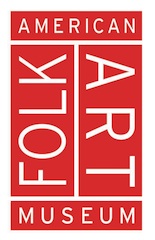
The American Folk Art Museum is an art museum in the Upper West Side of Manhattan in New York City, at 2 Lincoln Square, Columbus Avenue at 66th Street. It is the premier institution devoted to the aesthetic appreciation of folk art and creative expressions of contemporary self-taught artists from the United States and abroad.
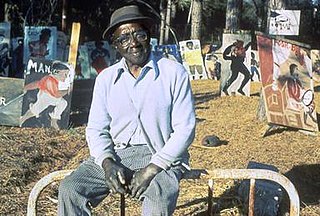
Thomas "Sam" Doyle (1906–1985) was an African-American artist from Saint Helena Island, South Carolina. His colorful paintings on sheet metal and wood recorded the history and people of St. Helena's Gullah community.
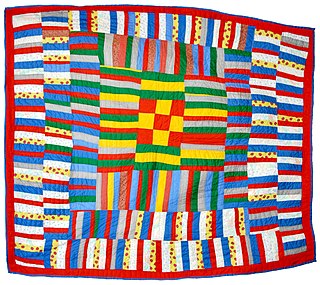
The quilts of Gee's Bend are quilts created by a group of women and their ancestors who live or have lived in the isolated African-American hamlet of Gee's Bend, Alabama along the Alabama River. The quilts of Gee's Bend are among the most important African-American visual and cultural contributions to the history of art within the United States. Arlonzia Pettway, Annie Mae Young and Mary Lee Bendolph are among some of the most notable quilters from Gee's Bend. Many of the residents in the community can trace their ancestry back to enslaved people from the Pettway Plantation. Arlonzia Pettway can recall her grandmother's stories of her ancestors, specifically of Dinah Miller, who was brought to the United States by slave ship in 1859.

Thornton Dial was a pioneering American artist who came to prominence in the late 1980s. Dial's body of work exhibits formal variety through expressive, densely composed assemblages of found materials, often executed on a monumental scale. His range of subjects embraces a broad sweep of history, from human rights to natural disasters and current events. Dial's works are widely held in American museums; ten of Dial's works were acquired by the Metropolitan Museum of Art in 2014.

Joyce J. Scott is an African-American artist, sculptor, quilter, performance artist, installation artist, print-maker, lecturer and educator. Named a MacArthur Fellow in 2016, and a Smithsonian Visionary Artist in 2019, Scott is best known for her figurative sculptures and jewelry using free form, off-loom beadweaving techniques, similar to a peyote stitch. Each piece is often constructed using thousands of glass seed beads or pony beads, and sometimes other found objects or materials such as glass, quilting and leather. In 2018, she was hailed for working in new medium — a mixture of soil, clay, straw, and cement — for a sculpture meant to disintegrate and return to the earth. Scott is influenced by a variety of diverse cultures, including Native American and African traditions, Mexican, Czech, and Russian beadwork, illustration and comic books, and pop culture.

John Bunion (J.B.) Murray was an abstract expressionist painter from Glascock County, GA. His work has been shown among folk art exhibitions and is included at the American Folk Art Museum and the Smithsonian American Art Museum, and has been featured in many museum exhibitions, including "Self-Taught Genius" at AFAM and "When the Stars Begin to Fall" at the Studio Museum. His work is best known for its codified use of colors and improvised script, called "spirit script," which could only be translated by the artist.
Nancy Morrison Crow is an American art quilter and fiber artist. She is one of the leading figures in the development of the art quilting movement of the 1970s and 1980s, and is also known for her development of certain techniques to allow more spontaneity and expression.
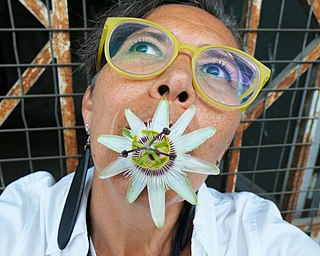
Blanka Amezkua is a Mexican-American Latinx inter-disciplinary contemporary artist. Collaboration, radical pedagogy, and community building are central to her art making and projects. Formally trained as a painter, her creative practice is greatly influenced and informed by folk art and popular culture, from papel picado to comic books.
Wini "Akissi" McQueen is an American quilter based in Macon, Georgia. Her artistic production consists of hand-dyed accessories and narrative quilts. Her techniques for her well-known quilts include an image transferring process. In her work, she tackles issues of race, class, society, and women. Her quilts have featured in many museum exhibitions, including the Museum of African American Folk Art, the Taft Museum, the Bernice Steinbam Gallery, and the William College Art Museum. In 2020, her quilts were featured in a retrospective dedicated to her textile art at the Museum of Arts & Sciences in Macon, GA.
Martha Cole is a Canadian artist. She is known for her work with textiles, landscape, and artist's books, addressing themes of inter-contentedness, sustainability, and protection of ecological diversity. She currently resides in Disley, Saskatchewan. Cole's high school art teacher, Helmut Becker encouraged her to pursue a career in art. She was an instructor in the Extension Division, Fine Arts and Humanities, University of Regina.
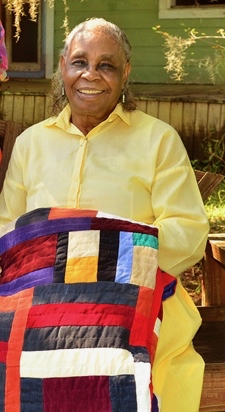
Mary Lee Bendolph is an American quilt maker of the Gee's Bend Collective from Gee's Bend (Boykin), Alabama. Her work has been influential on subsequent quilters and artists and her quilts have been exhibited in museums and galleries around the country. Bendolph uses fabric from used clothing for quilting in appreciation of the "love and spirit" with old cloth. Bendolph has spent her life in Gee's Bend and has had work featured in the Philadelphia Museum of Art as well as the Minneapolis Institute of Art in Minnesota.

Lucy Marie (Young) Mingo is an American quilt maker and member of the Gee's Bend Collective from Gee's Bend (Boykin), Alabama. She was an early member of the Freedom Quilting Bee, which was an alternative economic organization created in 1966 to raise the socio-economic status of African-American communities in Alabama. She was also among the group of citizens who accompanied Martin Luther King Jr. on his 1965 march from Selma to Montgomery, Alabama.

Johannes Spitler was an American painter of furniture.
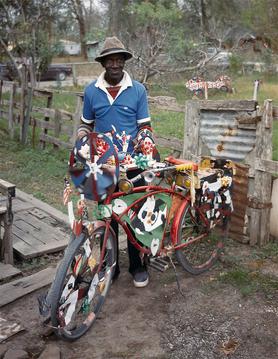
David Butler (1898–1997) was an African American sculptor and painter from Good Hope, Louisiana. His style is epitomized by kinetic sculptures made from recycled tin or wood, which he embellished with saturated colors and geometric patterns. His work is now in the permanent collections of the Smithsonian American Art Museum, the American Folk Art Museum, and the Philadelphia Museum of Art.
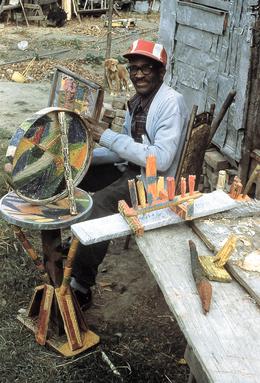
Leroy Person (1907–1985) was an American sculptor and wood carver from a remote region in northeastern North Carolina. Person's sculptures, and later, drawings, are recognized for their particular sensitivity to color and surface markings.
Eli Leon (1935–2018) born as Robert Stanley Leon, was an American psychologist, writer and collector. As a self-taught scholar of African-American quilts, he helped bring attention to the field and especially to the quilts of Rosie Lee Tompkins.

Yvonne Wells is an African-American folk artist and quilter from Tuscaloosa, Alabama. She is best known for her self-taught style and her story quilts depicting scenes from the Bible and the Civil Rights Movement. Her work has been exhibited at the Smithsonian National Museum of African American History and Culture and at the International Quilt Museum.
Stacy C. Hollander is a scholar of American self-taught art and former American museum curator. She was the deputy director of curatorial affairs, chief curator, and director of exhibitions of the American Folk Art Museum. She also served as interim director of the museum in 2018.
References
- ↑ "Kaleidoscope Quilts: The Art of Paula Nadelstern | American Folk Art Museum". folkartmuseum.org. Retrieved 2018-10-27.
- ↑ "Kaleidoscopic Quilts: Paula Nadelstern | American Craft Council". American Craft Council. Retrieved 2018-10-27.
- ↑ "Results – Search Objects – eMuseum". collection.folkartmuseum.org. Retrieved 2018-10-27.
- ↑ United, Brooklyn. "Exhibition - Self-Taught Genius". selftaughtgenius.org. Retrieved 2018-10-27.
- ↑ Paula., Nadelstern (1996). Kaleidoscopes & quilts. Lafayette, CA: C & TPub. ISBN 1571200185. OCLC 34546584.
- ↑ "artnet.com Magazine News". www.artnet.com. Retrieved 2018-10-27.
- ↑ LLC, @ads-llc.com - Applied Dynamic Solutions. "brio_winners_2018". www.bronxarts.org. Retrieved 2018-10-27.